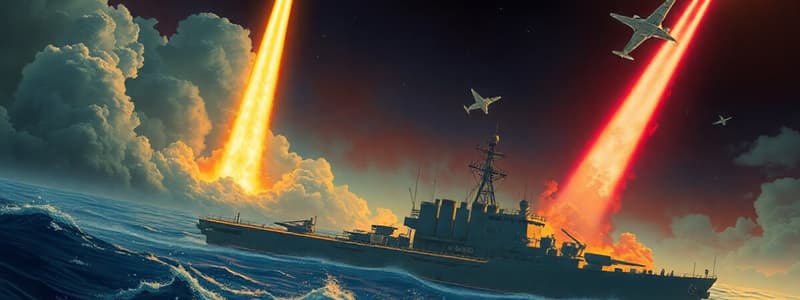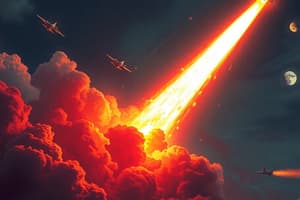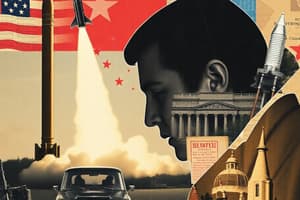Podcast
Questions and Answers
What was Dennison's primary responsibility as the unified commander for the Caribbean?
What was Dennison's primary responsibility as the unified commander for the Caribbean?
- Readying assault forces for a possible invasion of Cuba (correct)
- Establishing diplomatic relations with Caribbean countries
- Preparing for icy confrontations with Soviet forces
- Coordinating humanitarian missions in Caribbean nations
Which fleet unit was poised to launch strikes against Soviet and Cuban forces?
Which fleet unit was poised to launch strikes against Soviet and Cuban forces?
- The First Fleet under Admiral Brown
- The Second Fleet under Vice Admiral Alfred G. Ward (correct)
- The Third Fleet under Admiral Johnson
- The Fourth Fleet under Admiral Smith
Which country did Dennison coordinate maritime support operations with?
Which country did Dennison coordinate maritime support operations with?
- China and France
- Japan and Australia
- Germany and Italy
- Canada, Britain, Argentina, and Venezuela (correct)
What was President Kennedy's approach during the Cold War confrontation?
What was President Kennedy's approach during the Cold War confrontation?
What was the main consequence for Khrushchev as a result of the situation?
What was the main consequence for Khrushchev as a result of the situation?
What event in 1962 brought the U.S. and the Soviet Union close to nuclear war?
What event in 1962 brought the U.S. and the Soviet Union close to nuclear war?
What was the initial response of the United States to the construction of ballistic missile launch sites in Cuba?
What was the initial response of the United States to the construction of ballistic missile launch sites in Cuba?
Who was the Soviet Premier who initiated the deployment of missiles to Cuba?
Who was the Soviet Premier who initiated the deployment of missiles to Cuba?
What role did the U.S. Navy play during the Cuban Missile Crisis?
What role did the U.S. Navy play during the Cuban Missile Crisis?
What was the outcome of the Cuban Missile Crisis?
What was the outcome of the Cuban Missile Crisis?
What was Khrushchev's rationale for deploying missiles to Cuba?
What was Khrushchev's rationale for deploying missiles to Cuba?
How did U.S. intelligence first respond to the missile deployments in Cuba?
How did U.S. intelligence first respond to the missile deployments in Cuba?
What was one of the key military resources the U.S. Navy operated during the crisis?
What was one of the key military resources the U.S. Navy operated during the crisis?
Flashcards
Unified Commander for the Caribbean
Unified Commander for the Caribbean
The commander in charge of all US military branches preparing for a possible invasion of Cuba during the Cuban Missile Crisis.
Second Fleet
Second Fleet
The US Navy fleet responsible for launching attacks against Soviet and Cuban forces in Cuba.
Guantanamo Bay Naval Base
Guantanamo Bay Naval Base
The US naval base in Cuba that was reinforced by US forces during the Cuban Missile Crisis.
Nikita Khrushchev
Nikita Khrushchev
Signup and view all the flashcards
John F. Kennedy
John F. Kennedy
Signup and view all the flashcards
Cuban Missile Crisis
Cuban Missile Crisis
Signup and view all the flashcards
Soviet Missile Deployment
Soviet Missile Deployment
Signup and view all the flashcards
Naval Blockade
Naval Blockade
Signup and view all the flashcards
Naval Power in Cuban Missile Crisis
Naval Power in Cuban Missile Crisis
Signup and view all the flashcards
Polaris Submarines
Polaris Submarines
Signup and view all the flashcards
US Naval Deployment
US Naval Deployment
Signup and view all the flashcards
US Navy's Intelligence Role
US Navy's Intelligence Role
Signup and view all the flashcards
Aerial Reconnaissance During the Cuban Missile Crisis
Aerial Reconnaissance During the Cuban Missile Crisis
Signup and view all the flashcards
Study Notes
Cuban Missile Crisis (1962)
- Soviet Premier Khrushchev secretly deployed medium and intermediate-range ballistic missiles to Cuba.
- These missiles threatened US cities and military targets.
- US intelligence discovered the deployment.
- The Cuban Missile Crisis arose.
- President Kennedy and the US government, military, and public pressured the Soviets.
- The Soviets removed missiles and offensive weapons from Cuba.
US Navy's Role
- The US Navy was crucial to the outcome.
- It demonstrated the importance of naval forces to national defense.
- The Navy strategically employed military power, avoiding war.
- Naval forces demonstrated a clear advantage over Soviet missiles and bombers.
- The Navy maintained a naval quarantine of Cuba, intercepting shipping and Soviet submarines.
- Radar picket ships and airborne early warning assisted in Air Defense Command preparations.
- Navy aircraft observed the deployment and withdrawal of Soviet weapons.
- Naval forces were prepared for a possible invasion of Cuba.
- Other allied forces (Canada, Britain, Argentina, Venezuela) assisted.
Soviet Response
- Khrushchev, facing US and Allied strength, had limited options.
- The Soviet Union ultimately removed their missiles and offensive weapons.
- Kennedy did not exploit the advantage gained by US military strength.
Key Figures
- Nikita Khrushchev: Soviet Premier
- John F. Kennedy: US President
- Robert L. Dennison: Commander US Atlantic Command
- Alfred G. Ward: Vice Admiral, Second Fleet
Studying That Suits You
Use AI to generate personalized quizzes and flashcards to suit your learning preferences.
Description
Explore the pivotal role of the US Navy during the Cuban Missile Crisis of 1962. This quiz examines how naval power and strategies were effectively used to prevent potential war while addressing the Soviet threat. Test your knowledge on the events that shaped national defense and military strategy during this critical period.





